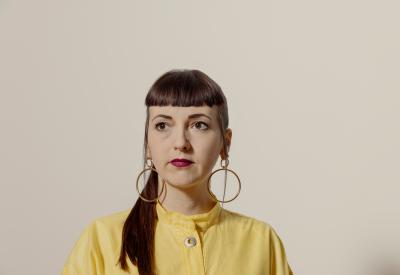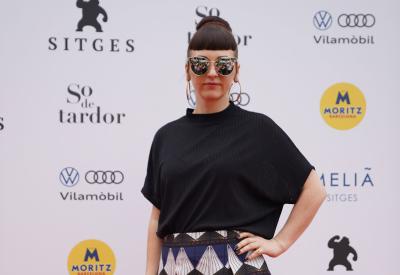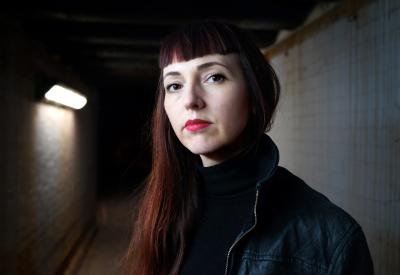- Home
- Latest
- Prano Bailey-Bond

Interview
Prano Bailey-Bond
“I tend to lean towards exploring stories of dark psychology”
20 Jul 2022
Reading 5 min.
WomanInFan New Talents
Interview with Prano Bailey-Bond
Prano was named a 2021 “Director to Watch” by Variety and a Screen International “Star of Tomorrow” in 2018. Prano’s debut feature film, Censor, starring Niamh Algar and supported by the BFI, Film4 and Ffilm Cymru Wales, opened the Midnight section of the 2021 Sundance Film Festival, went on to be selected for the Berlin Film Festival’s Panorama section and was selected at Sitges - International Fantastic Film Festival of Catalonia in the Official Fantastic Competition section.
The beginnings
Several things collided to make me want to be a filmmaker. I used to love painting and drawing. And I also loved watching films, so I would paint and draw whilst absorbing movies. And I loved performance and actually thought I wanted to be an actress. But when I started to study performance, I realized I was much more interested in being on the outside, shaping things. And that by directing and making films, I was able to bring together my love of all these things, story, visual arts and performance. It felt like everything married together in film, in directing.
'Blue Velvet', the revelation
There were many films that I was inspired by, and loved, and influenced me. But I think one that I could cite as a big influence, or that showed me the potential of what cinema could be was Blue Velvet by David Lynch. When I saw that, I understood how cinema could take the internal and manifest the internal life of a character in the external world. For me that was quite revolutionary. And in terms of me understanding what you could do with a story in cinema; how you could use cinema in an expressionistic way to explore ideas. So that is always one that I go back to again and again, and I keep finding things forever in that film. It’s so clever.
Love for genre
I do feel that I inherently lean towards genre. I’d say most of my work is genre adjacent in some way. I tend to lean towards exploring stories of dark psychology, or even sometimes dark comedy. But I didn’t realize I was making genre work at first. I was just telling the stories I was interested in and there was something about the way I wanted to explore the dark sides of characters that leaned into genre. So I realized I was making genre. And I just accepted that. I love genre. I think it’s part of my identity.
Inspiration comes from…
It can be different things all the time, which is amazing. Sometimes you’re inspired by the front of a building or something strange like that. But more frequently, it’s characters that I’m inspired by; the idea of a character in a specific world, which I get obsessed with and want to understand. Sometimes it might be a bigger, more philosophical idea that connects to that something in that character’s life. So, it can be a fusion of those things. Then when it comes down to writing, I always start with character. I’ll have a visual world that I can picture or an atmosphere I’m holding onto for this film, but it’s always character at the centre of that, you know… what’s their journey, what they want. Images are helpful along the way too because they can help you to hold onto the feeling or the world that you’re trying to create. Sometimes those images will stay all the way to the end, and still be there in the final film. And that’s something magical. Sometimes the images must fall away, like cutting an umbilical cord. You know… it’s a way into the project, but it doesn’t belong in the film.
The genesis of 'Censor'
I was on a plane reading this article about Hammer Horror in 2012. In the article, it said, that during the Hammer Horror era, censors didn’t have many rules, but one of the rules was that they would cut the sight of blood on the breast of a woman, because they believed it would make men likely to commit rape. And I thought, well, what protected the censor from losing control? If those images are supposed to have that effect? What if a censor started to question their moral compass based on these ideas? And that was the seed; I wanted to explore this character who was having a very complicated conversation with themselves, their morals, in relation to what they’re seeing on screen. Then, I landed in the ‘video nasty’ era, because in Britain everybody was having that conversation with horror films; we were being told these horror films were going to poison our minds and turn us all into evil monsters.
Monsters like Fulci…
Going back to a period like this and a subject matter like this, you’ve got this wealth of influences in the ‘video nasties’. I always knew that I wanted part of the texture of this film and the visual language of this film to chime with this era of VHS horror. So, I was going back and looking at work by Dario Argento, Lucio Fulci… a lot of the video nasties. Videodrome was an influence as well. These styles and filmmakers really align with my own tastes. I also wanted to create a 1980s Britain, the reality world of the film, that’s like the world we see when we look out the window, rather than the world we see in an 80’s magazine – avoiding, you know, fashion focused big shoulder pads, big earrings, that kind of thing. So, I went back and started looking at photography projects from the period and there was a photography project called Beyond Caring by Paul Graham. The images are of people going and collecting their dole cheques, you know, and they were just drab, really kind of quite miserable… I’m talking about this oppressive, grey, Thatcher’s Britain. I wanted to take the journey of the film visually from that world into the world of ‘video nasties’, of Fulci and Argento.
A suggestion for the newcomers
Remember that you’re not expected to know everything at this point. So be open; arm yourself by talking to other filmmakers about their experiences. Prepare yourself for the journey of your debut by talking candidly to directors, or producers who have already trodden the path. Be honest with yourself about the things that you don’t know, then dig into those areas through research and preparation. It’s all about preparation. But remember to enjoy the experience as well, and look after yourself. Eat well. Sleep well. Yeah, be kind to yourself along the way.
And for the pitch…
I think practice pitching is the best advice. I was so nervous when I started pitching Censor to, you know, a crowd or to a potential financier, for example. But the more you tell the story, whether that’s to your friend, your parent, a stranger you meet in a party - whoever… just practice telling the story and see when people’s eyes light up, or when they glaze over; and then you’ll work out the best way to tell your story. Once you’ve got that down it will just be a natural reflex you’ll never forget, like riding a bike.
Previous content
Sitges hosts the next edition of the Torino Green Film LabNext content
Interview with David Casademunt

